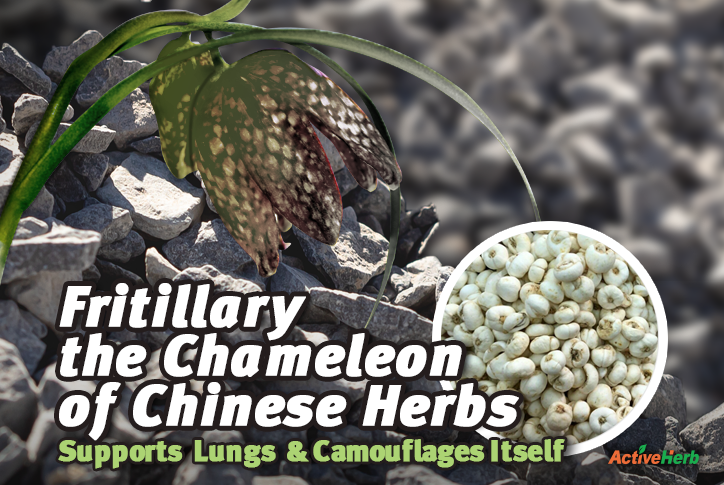The Chameleon Of Chinese Herbs: How Fritillary Supports The Lungs & Camouflages Itself

The Hengduan Mountains of southwestern China is home to the world’s most diverse species of alpine zone plants. The flora here thrives despite the inhospitable wind and subfreezing temperatures. Plants in this corner of the Far East have continuously existed for far longer than any other mountain-range plants on Earth.
One remarkable plant in this area that borders the Himalayan plateau is Fritillaria. Not only has Fritillaria survived the harsh conditions, it has developed a most intriguing defense mechanism: camouflage.
Fritillary: The Chinese Herb That Hides From People
Something remarkable about fritillaria has been recently discovered in its native habitat. Used for over 2,000 years to support respiratory health, the herb has developed the ability to transform its pigment from green to brown, in order to blend in with the jagged, loose rocks. Fritillaria normally sprouts out of soil covered by mountain scree, appearing bright green or yellow, which makes it easy to spot.
Animal camouflage is in itself a most interesting phenomenon. But in plants, it’s extremely rare. And what makes fritillaria camouflage even more of an oddity is that the plant isn’t hiding itself from voracious herbivores such as mountain goats, attracted to the bright green hue of the plant.
Rather, fritillaria is hiding from humans.
Demand for fritallaria’s lung-health-supporting properties has skyrocketed in China. As such, the plant has seemingly very quickly adopted a novel way to evade detection in areas where the herb is being overharvested.
This may very well be the first instance of human activity being the driving force behind botanical evolution.
Fritillaria has developed the ability to emerge incognito from the rocky soil brown, barely detectable against the loose rocks of the same tint.
The findings of this remarkable botanical evolutionary development was recently published in the journal Current Biology.
Fritillaria Overharvesting
It’s a good thing Fritillaria has learned how to be a chameleon. Demand and price for the plant’s bulbs, which is crushed into powder form, has increased exponentially. The powder now sells for approximately $218 a pound.
Fritillaria takes a long time to flower. It requires at least five growing seasons to produce the raw material necessary for the building blocks of the medicinal herb. Just one pound of powder requires approximately 3,500 individual plants.
ActiveHerb Fritillaria Thunberg
The particular species of camouflaged Fritillaria that the researchers studied is Fritillaria delavayi. ActiveHerb offers a different species of Fritillaria, F. Thunberg. Also known as Bei Mu, ActiveHerb’s Fritillaria is available as single extract granules, which can be made into an instant hot tea.
F. Thunberg is also an ingredient in our respiratory-support formula LungVigor, which nourishes Lung Yin Qi. In traditional Chinese medicine theory, Bei Mu moistens the lungs and transforms phlegm.
Fritillary bulb, which possesses bitter and cold properties, appropriate considering the climate it comes from, also clears heat and disperses lumps. It acts on the Lung and Heart organ systems. Preliminary research studies support Bei Mu for its traditional uses.
ActiveHerb uses sustainably-sourced Fritillary bulbs.
Proof Of Camouflage
According to ScienceNews, authors of the Current Biology-published study used an instrument called a spectrometer to measure how closely the color of the plants matched their environment. The researchers also kept records at seven different locations to assess harvesting data from 2014 to 2019.
The researchers discovered that plants in areas that underwent the most harvesting developed the most intense camouflage pattern, mimicking the backdrop of the mountain range. And in the hardest-to-reach areas, where harvesting occurred the least, the plants maintained their natural green coloration.
A remarkable feat of adaptation by a remarkable traditional Chinese herb.
References:
Hengduan Mountain alpine flora history shown to be longest on Earth
Commercial Harvesting Has Driven the Evolution of Camouflage in an Alpine Plant
These plants seem like they’re trying to hide from people
Fritillariae Thunbergii Bulbus: Traditional Uses…







